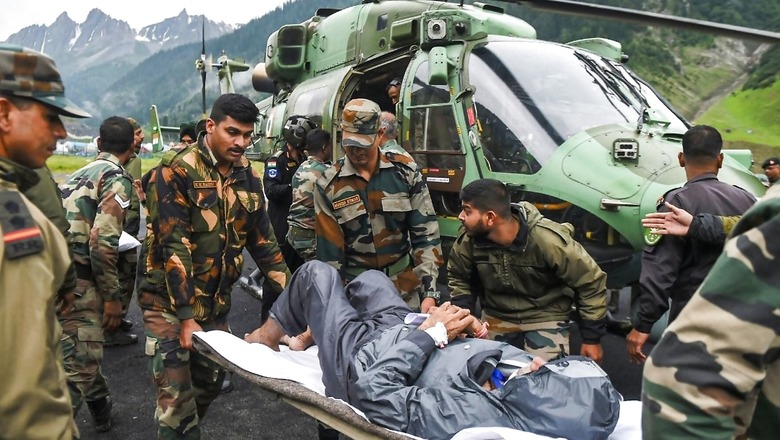
views
The ferocious flash flood near the Amarnath cave that swept away over 50 people, killing at least 16 of them on July 8, was triggered by a cloudburst in the upper reaches which remain inaccessible to the country’s weather department, said India Meteorological Department (IMD) head M Mohapatra in the aftermath of the tragedy.
“We have 15 automatic weather stations along the Yatra route, and one automatic weather station just over the Amarnath cave which reported around 28mm rain. But that does not mean there was no cloudburst. Certainly, there has been rainfall away from the holy cave in the upper reaches because of which the water came gushing down the hills. Since we do not have any observatory up there, we cannot confirm. But we cannot rule it out either," said Mohapatra, while speaking exclusively to News18.
Ever since the tragedy struck the pilgrimage site, which is covered by snow most of the year, there have been doubts over the initial cause. While the authorities have clearly attributed it to cloudburst from day one, the country’s weather department continued to maintain that it was “a highly localized, heavy rainfall event", and not a cloudburst which is recorded when the clouds suddenly dump at least 100mm rain within an hour.
Speaking to News18, the director general of meteorology said the region is highly prone to cloudburst, especially during the monsoon season — which is also the time when the holy shrine is opened for devotees — and these small-scale weather events are extremely challenging to predict.
“A cloudburst is a very highly localized event, with a size of 1 kilometre or even less, and a short life cycle of few minutes or less than an hour. Its detection itself is very difficult, especially in western Himalayan region where there are so many higher reaches and ground observations are nearly impossible. We can only depend on remotely sensed observations from satellites and radars," he added.
Satellites can provide data every half an hour, which indicates cloud development, intensity and its movement. Based on this, the department issues forecast for heavy or intense rains. But, in between, a cloudburst can occur. Radars, on the other hand, have higher resolution, provide data every 10 minutes, and can detect clouds holding more water.
“Radars are our best bet, but even they have their own limitations. Their radiations can get obstructed by hill ranges. Often these tall, dense convective clouds less than 1 kilometre can escape the radar. We will not get many pixels to describe that type of convective clouds. The clouds behind a hill will also not be covered. It is not possible to increase their number, since there are challenges of accessibility, network connectivity and availability of land," he said. “The resolution of visual images from these radars is still 1 km, but for Infrared (IR) images (day and night) it is 4 km."
There are now four X-band radars in the western Himalayan region worth Rs 6.5 crore each with a range of 100 kilometres in Srinagar, Leh, Jammu and another is coming up in Banihal near the Amarnath cave. Hit by operational delays, the radar will be operational within the next few days, said Mohapatra.
“But even then, one cannot predict cloudburst," said the IMD head. “In fact, not just India, but cloudburst cannot be predicted anywhere in the world because we do not have the numerical models with a capacity to predict events of such small scale. All we can do is predict an intense spell of heavy rainfall. For that type of scale, we need observations and computational models. The current state-of-art numerical models do not have the capacity to predict these events worldwide."
A week into the tragedy, the search operation is still on for close to 30 people who are believed to be missing since the flash floods ravaged the base camp, situated near the cave.
Meanwhile, former Jammu and Kashmir chief minister Farooq Abdullah has demanded an enquiry into why the tents were placed so close to the site that is most vulnerable to floods.
The 43-day annual Yatra began on June 30 after a gap of three years, with a batch of over 2,700 pilgrims. It has already seen an inflow of close to 1 lakh pilgrims, and another batch of nearly 7,000 devotees has left the Jammu base camp towards the cave after the Yatra resumed early this week. It will culminate on August 11.
Read all the Latest News, Breaking News, watch Top Videos and Live TV here.
















Comments
0 comment